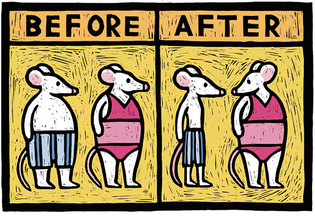 loading
loading
FindingsHis-and-hers fat cellsThere’s a reason men lose weight easier than women.  Gregory NemecView full imageThe mantra is ubiquitous: to slim down, move more and eat less. But the biology of obesity is not nearly that simple; some people gain weight much more readily than others, and weight loss and weight loss maintenance may present particular challenges for women. “We have known very little about how fat cells form and create obesity,” says Matthew Rodeheffer, associate professor of comparative medicine, who has been working for over a decade on understanding fat cell behavior. In a recent experiment, the results of which were published in the journal Cell Metabolism, Rodeheffer and his team fed a high-fat diet to both male and female mice. They found that, in male mice, the high-fat diet increased the number of fat cells in only the visceral white adipose tissue (VWAT)—fat stored in the abdominal cavity. However, in female mice, the same diet resulted in an increase in the number of fat cells in both VWAT and subcutaneous white adipose tissue (SWAT)—fat that collects under the skin. Significant weight gain results in the creation of additional fat cells by a mechanism that Rodeheffer says is not currently understood but that he describes as a “quick burst” of fat cell formation. What is known is that, once a person becomes obese, subsequent weight loss shrinks only the size of the fat cells, not their number. “In other words,” he says, “once the fat cells have developed, they stick around.” The difference Rodeheffer found between male and female patterns of fat cell gain may affect the ability of women to lose weight and maintain weight loss. Continuing research into obesity overall, and into the gender differences in fat cell behavior, Rodeheffer says, could lead to more effective interventions to help the obese.
The comment period has expired.
|
|